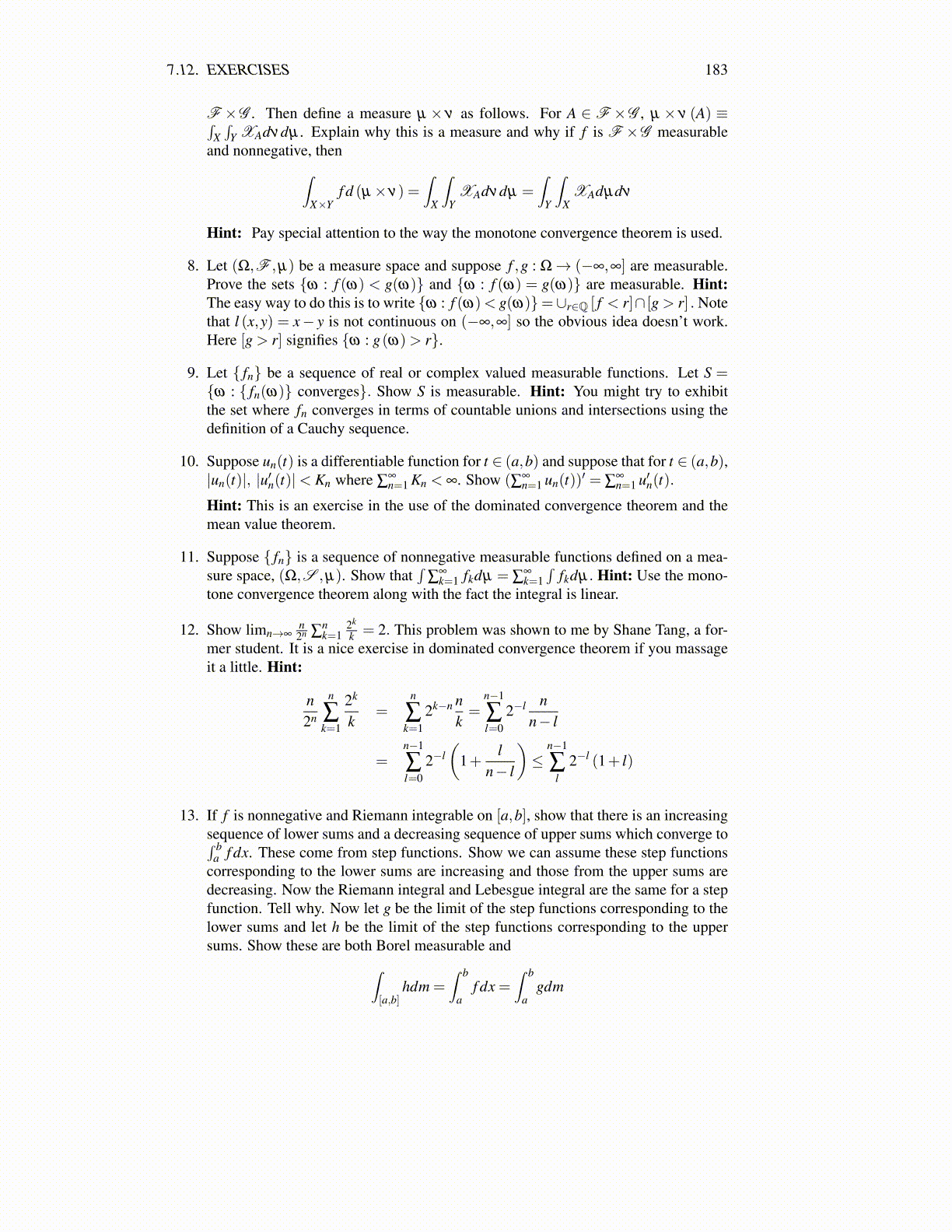
7.12. EXERCISES 183
F ×G . Then define a measure µ × ν as follows. For A ∈ F ×G , µ × ν (A) ≡∫X∫
Y XAdνdµ . Explain why this is a measure and why if f is F ×G measurableand nonnegative, then∫
X×Yf d (µ×ν) =
∫X
∫Y
XAdνdµ =∫
Y
∫X
XAdµdν
Hint: Pay special attention to the way the monotone convergence theorem is used.
8. Let (Ω,F ,µ) be a measure space and suppose f ,g : Ω→ (−∞,∞] are measurable.Prove the sets {ω : f (ω) < g(ω)} and {ω : f (ω) = g(ω)} are measurable. Hint:The easy way to do this is to write {ω : f (ω)< g(ω)}=∪r∈Q [ f < r]∩ [g > r] . Notethat l (x,y) = x− y is not continuous on (−∞,∞] so the obvious idea doesn’t work.Here [g > r] signifies {ω : g(ω)> r}.
9. Let { fn} be a sequence of real or complex valued measurable functions. Let S ={ω : { fn(ω)} converges}. Show S is measurable. Hint: You might try to exhibitthe set where fn converges in terms of countable unions and intersections using thedefinition of a Cauchy sequence.
10. Suppose un(t) is a differentiable function for t ∈ (a,b) and suppose that for t ∈ (a,b),|un(t)|, |u′n(t)|< Kn where ∑
∞n=1 Kn < ∞. Show (∑∞
n=1 un(t))′ = ∑∞n=1 u′n(t).
Hint: This is an exercise in the use of the dominated convergence theorem and themean value theorem.
11. Suppose { fn} is a sequence of nonnegative measurable functions defined on a mea-sure space, (Ω,S ,µ). Show that
∫∑
∞k=1 fkdµ = ∑
∞k=1
∫fkdµ. Hint: Use the mono-
tone convergence theorem along with the fact the integral is linear.
12. Show limn→∞n2n ∑
nk=1
2k
k = 2. This problem was shown to me by Shane Tang, a for-mer student. It is a nice exercise in dominated convergence theorem if you massageit a little. Hint:
n2n
n
∑k=1
2k
k=
n
∑k=1
2k−n nk=
n−1
∑l=0
2−l nn− l
=n−1
∑l=0
2−l(
1+l
n− l
)≤
n−1
∑l
2−l (1+ l)
13. If f is nonnegative and Riemann integrable on [a,b], show that there is an increasingsequence of lower sums and a decreasing sequence of upper sums which converge to∫ b
a f dx. These come from step functions. Show we can assume these step functionscorresponding to the lower sums are increasing and those from the upper sums aredecreasing. Now the Riemann integral and Lebesgue integral are the same for a stepfunction. Tell why. Now let g be the limit of the step functions corresponding to thelower sums and let h be the limit of the step functions corresponding to the uppersums. Show these are both Borel measurable and∫
[a,b]hdm =
∫ b
af dx =
∫ b
agdm